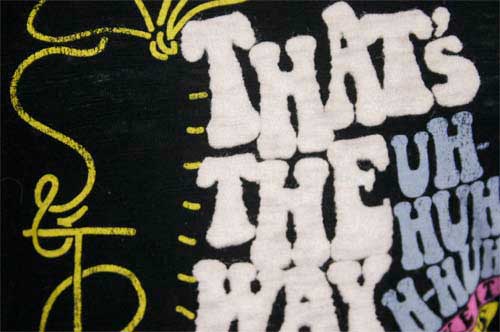
Everybody has that lifelong favorite t-shirt with the faded color, slight tear, and small but noticeable ketchup stain. Why do these tees continue to stay in the closet and out of the trash? Well, aside from the ketchup stain, people like the vintage, worn-out look.
Using specialized inks, decorating manufacturers are able to give a brand-spanking-new shirt the look of an old-worn-out tee. The three types of inks that give printed t-shirts a vintage look and feel are water-based, discharge (which is water-based inks for dark garments), and soft-hand additives.
Each ink has its' own advantages and disadvantages, and the decorating manufacturer should consult with the client to select the ink that will give the best results for what they wish to accomplish.
Soft-Hand Additives
ABOUT
- Sometimes referred to as Chino or Fashion Soft, this ink is a plastisol mixed with PMS ink.
- Prints on light garments only. Inks tend to be a little more transparent than the PMS counterparts.
ADVANTAGES
- Creates and leaves the printed t-shirt with a "soft-hand" feel.
- Using this ink, the print stays truer to the design.
DISADVANTAGES
- Not for use on dark garments.
- The use of an under-base would negate the soft feel of the print and because the inks are more transparent.
- They tend to have a water-color look when printed on a white base.
- Some clients prefer water-based because of the notoriety it has received in the fashion industry, and though technically it is not water-based, the print result is the same or sometimes better.
Water-Based Inks
ABOUT
- This ink is too transparent for dark shirts and should only be printed on light garments.
ADVANTAGES
- When dealing with these inks, colors tend to look flat, giving the garment the vintage look that many people are attracted to.
- After the ink is cured, the t-shirt is left with a "soft-hand" feeling and the print gets even softer upon the first wash.
DISADVANTAGES
- These inks need to be kept moist; if they aren't, the water will evaporate and the ink will dry in the screen causing damage to the stencil of your logo or design. To deal with this issue, have a production member regularly mist the ink or keep a humidifier beneath the screen.
- Due to the fact that these inks dry so quickly, it is best to keep under a 5-color print job.
- Hard to hold detail of screen printed designs or logos.
Discharge Inks
ABOUT
- This ink should only be used on dark colored and 100% cotton fabric.
- Discharge ink is water-based ink with an activator.
- The activator is a chemical component that removes fabric color while simultaneously replacing it with the pigment to produce the desired screen print colors.
ADVANTAGES
- Like water-based and soft additives, discharge ink leaves the finished garment with a “soft-hand” feel.
DISADVANTAGES
- Any fabric printed with discharge ink should be washed before wearing due to the chemical nature of the product and potential to irritate sensitive skin.
- Different colored shirts respond differently. Vibrant colors such as royal, purple, and red, discharge less perfectly. Discharging effects vary from dye lot to dye lot and is impossible to predict exact results.
- Natural tendency to dry around the edges of the stencil, altering the look of the design.
For more information and details, get a hold of us!!










-1.png?width=280&name=Sharprint%20Decorated%20Apparel%20Logo%20(40%20KB)-1.png)